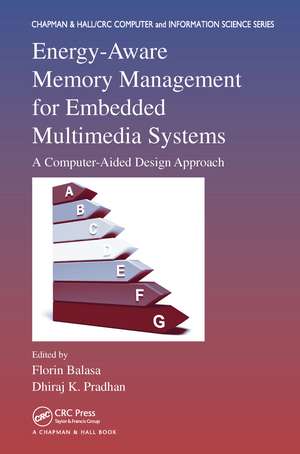Energy-Aware Memory Management for Embedded Multimedia Systems: A Computer-Aided Design Approach: Chapman & Hall/CRC Computer and Information Science Series
Editat de Florin Balasa, Dhiraj K. Pradhanen Limba Engleză Hardback – 16 noi 2011
The book covers various energy-aware design techniques, including data-dependence analysis techniques, memory size estimation methods, extensions of mapping approaches, and memory banking approaches. It shows how these techniques are used to evaluate the data storage of an application, reduce dynamic and static energy consumption, design energy-efficient address generation units, and much more.
Providing an algebraic framework for memory management tasks, this book illustrates how to optimize energy consumption in memory subsystems using CAD solutions. The algorithmic style of the text should help electronic design automation (EDA) researchers and tool developers create prototype software tools for system-level exploration, with the goal to ultimately obtain an optimized architectural solution of the memory subsystem.
Din seria Chapman & Hall/CRC Computer and Information Science Series
- 8%
 Preț: 305.97 lei
Preț: 305.97 lei - 18%
 Preț: 952.91 lei
Preț: 952.91 lei - 18%
 Preț: 749.73 lei
Preț: 749.73 lei - 27%
 Preț: 276.35 lei
Preț: 276.35 lei - 20%
 Preț: 589.61 lei
Preț: 589.61 lei - 20%
 Preț: 532.68 lei
Preț: 532.68 lei - 25%
 Preț: 298.12 lei
Preț: 298.12 lei - 20%
 Preț: 433.62 lei
Preț: 433.62 lei - 20%
 Preț: 264.71 lei
Preț: 264.71 lei - 20%
 Preț: 479.88 lei
Preț: 479.88 lei - 34%
 Preț: 478.40 lei
Preț: 478.40 lei - 31%
 Preț: 264.89 lei
Preț: 264.89 lei - 26%
 Preț: 849.77 lei
Preț: 849.77 lei - 26%
 Preț: 265.85 lei
Preț: 265.85 lei - 29%
 Preț: 259.81 lei
Preț: 259.81 lei - 20%
 Preț: 513.32 lei
Preț: 513.32 lei - 20%
 Preț: 482.39 lei
Preț: 482.39 lei - 20%
 Preț: 986.39 lei
Preț: 986.39 lei - 33%
 Preț: 408.36 lei
Preț: 408.36 lei - 20%
 Preț: 442.41 lei
Preț: 442.41 lei - 33%
 Preț: 975.17 lei
Preț: 975.17 lei - 30%
 Preț: 1243.62 lei
Preț: 1243.62 lei - 30%
 Preț: 275.76 lei
Preț: 275.76 lei - 23%
 Preț: 288.56 lei
Preț: 288.56 lei - 32%
 Preț: 325.85 lei
Preț: 325.85 lei - 20%
 Preț: 378.53 lei
Preț: 378.53 lei - 36%
 Preț: 839.62 lei
Preț: 839.62 lei - 34%
 Preț: 1167.33 lei
Preț: 1167.33 lei - 34%
 Preț: 1168.04 lei
Preț: 1168.04 lei
Preț: 1061.32 lei
Preț vechi: 1627.61 lei
-35% Nou
Puncte Express: 1592
Preț estimativ în valută:
203.11€ • 211.27$ • 167.68£
203.11€ • 211.27$ • 167.68£
Comandă specială
Livrare economică 24 martie-07 aprilie
Doresc să fiu notificat când acest titlu va fi disponibil:
Se trimite...
Preluare comenzi: 021 569.72.76
Specificații
ISBN-13: 9781439814000
ISBN-10: 1439814007
Pagini: 360
Ilustrații: 133 b/w images, 9 tables and 411
Dimensiuni: 156 x 234 x 23 mm
Greutate: 0.66 kg
Ediția:1
Editura: CRC Press
Colecția Chapman and Hall/CRC
Seria Chapman & Hall/CRC Computer and Information Science Series
ISBN-10: 1439814007
Pagini: 360
Ilustrații: 133 b/w images, 9 tables and 411
Dimensiuni: 156 x 234 x 23 mm
Greutate: 0.66 kg
Ediția:1
Editura: CRC Press
Colecția Chapman and Hall/CRC
Seria Chapman & Hall/CRC Computer and Information Science Series
Public țintă
Computer aided design researchers and graduate students, compiler writers and embedded system designers, and computer architects.Cuprins
Computer-Aided Design for the Energy Optimization in the Memory Architecture of Embedded Systems. The Power of Polyhedra. Computation of Data Storage Requirements for Affine Algorithmic Specifications. Polyhedral Techniques for Parametric Memory Requirement Estimation. Storage Allocation for Streaming-Based Register File. Optimization of the Dynamic Energy Consumption and Signal Mapping in Hierarchical Memory Organizations. Leakage Current Mechanisms and Estimation in Memories and Logic. Leakage Control in SoCs. Energy-Efficient Memory Port Assignment. Energy-Efficient Address-Generation Units and Their Design Methodology. Index.
Notă biografică
Florin Balasa is an associate professor in the Department of Computer Science and Engineering at the American University in Cairo. A senior member of IEEE, Dr. Balasa holds two patents and is an associate editor of the International Journal of Computers and Electrical Engineering. He has also been a recipient of a National Science Foundation CAREER Award. His research focuses on algorithms and software systems for VLSI design automation.
Dhiraj K. Pradhan is a chair and professor in the Department of Computer Science at the University of Bristol. A fellow of ACM, IEEE, and the Japan Society of Promotion of Science, Dr. Pradhan holds two patents and has been a recipient of the Humboldt Prize and Fulbright-Flad Chair in Computer Science. For more than thirty years, his research has focused on VLSI computer-aided design and testing as well as fault-tolerant computing, computer architecture, and parallel processing.
Dhiraj K. Pradhan is a chair and professor in the Department of Computer Science at the University of Bristol. A fellow of ACM, IEEE, and the Japan Society of Promotion of Science, Dr. Pradhan holds two patents and has been a recipient of the Humboldt Prize and Fulbright-Flad Chair in Computer Science. For more than thirty years, his research has focused on VLSI computer-aided design and testing as well as fault-tolerant computing, computer architecture, and parallel processing.
Descriere
Providing an algebraic framework for memory management tasks, this book illustrates how to optimize energy consumption in memory subsystems using CAD solutions. It covers data-dependence analysis techniques, memory size estimation methods, extensions of mapping approaches, and memory banking approaches. The book shows how these techniques are used to evaluate the data storage of an application, reduce dynamic and static energy consumption, design energy-efficient address generation units, and much more. The algorithmic style of the text should help readers create prototype software tools for system-level exploration.
